

BrainPOP - Animated Educational Site for Kids - Science, Social Studies, English, Math, Arts. Natial geagrafic knows everything. Icy moons. How Long Is A Day On Saturn? Measuring the rotation period of a rocky planet like the Earth is easy, but similar measurements for planets made of gas, such as Saturn, pose problems.
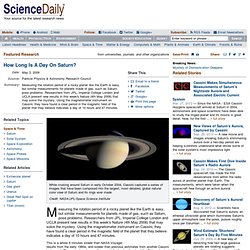
Researchers from JPL, Imperial College London and UCLA present new results in this week's Nature (4th May 2006) that may solve the mystery. Using the magnetometer instrument on Cassini, they have found a clear period in the magnetic field of the planet that they believe indicates a day of 10 hours and 47 minutes. This is a whole 8 minutes slower than NASA Voyager results from the early 1980s, and slower than previous estimates from another Cassini instrument. The magnetometer results provide the best estimate of the Saturn day to date, because it can see deep inside Saturn.
Planets rotate around their "spin" axes as they orbit about the Sun. Gaseous planets do not have a solid surface to track and are not as rigid as rocky planets. Temperature of Saturn. Want to stay on top of all the space news?
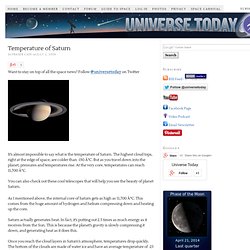
Follow @universetoday on Twitter It’s almost impossible to say what is the temperature of Saturn. The highest cloud tops, right at the edge of space, are colder than -150 °C. But as you travel down into the planet, pressures and temperatures rise. At the very core, temperatures can reach 11,700 °C. Saturn. What is the Weather on Saturn? - Ask. Saturn - The Planet Saturn - Saturn For Kids. Saturn is the sixth planet in the Solar system and, when seen through a telescope, by far the most beautiful.
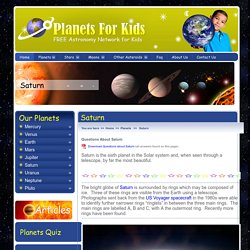
The bright globe of Saturn is surrounded by rings which may be composed of ice. Three of these rings are visible from the Earth using a telescope. Photographs sent back from the US Voyager spacecraft in the 1980s were able to identify further narrower rings “ringlets” in between the three main rings. The main rings are labelled A, B and C, with A the outermost ring. Recently more rings have been found. Figure 1: Photograph of Saturn taken from Voyager spacecraft.
Kids - Our Universe - Saturn's moons. View of Tethys beyond Saturn Saturn has 31 known moons – more than any other planet except Jupiter.

One of them, Titan, is planet-sized, but the others are much smaller. Most of the moons are icy, and covered with many round craters of different sizes. These have been dug by comets and rocky meteorites crashing into them. Tethys has a huge crater with a peak in the centre, making it look like the 'Death Star' in the Star Wars movies. Although their surfaces are extremely cold, some of the moons seem to be warm inside. Iapetus: light and dark. Fun Saturn Facts for Kids - Amazing Information About This Planets Cool Rings. 2nd largest planet. Titan. Saturns moons. How Long is a Year on Saturn? Want to stay on top of all the space news?
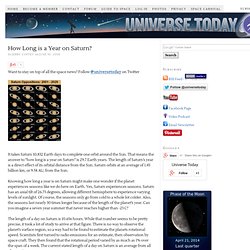
Follow @universetoday on Twitter It takes Saturn 10,832 Earth days to complete one orbit around the Sun. Saturn. Saturn means: Saturn was the Roman god of agriculture.
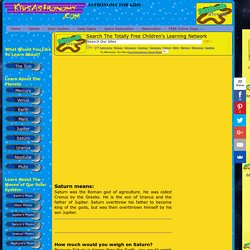
He was called Cronus by the Greeks. He is the son of Uranus and the father of Jupiter. Saturn overthrew his father to become king of the gods, but was then overthrown himself by his son Jupiter. How much would you weigh on Saturn? Huge planet. Facts about Saturn - Bob the Alien's Tour of the Solar System. Fact One Saturn is the second largest planet in the Solar System after Jupiter.
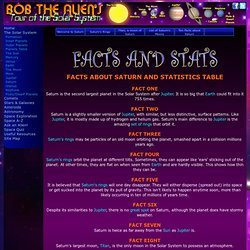
It is so big that Earth could fit into it 755 times. Fact Two Saturn is a slightly smaller version of Jupiter, with similar, but less distinctive, surface patterns. Like Jupiter, it is mostly made up of hydrogen and helium gas. Fact Three Saturn's rings may be particles of an old moon orbiting the planet, smashed apart in a collision millions years ago. Fact Four.